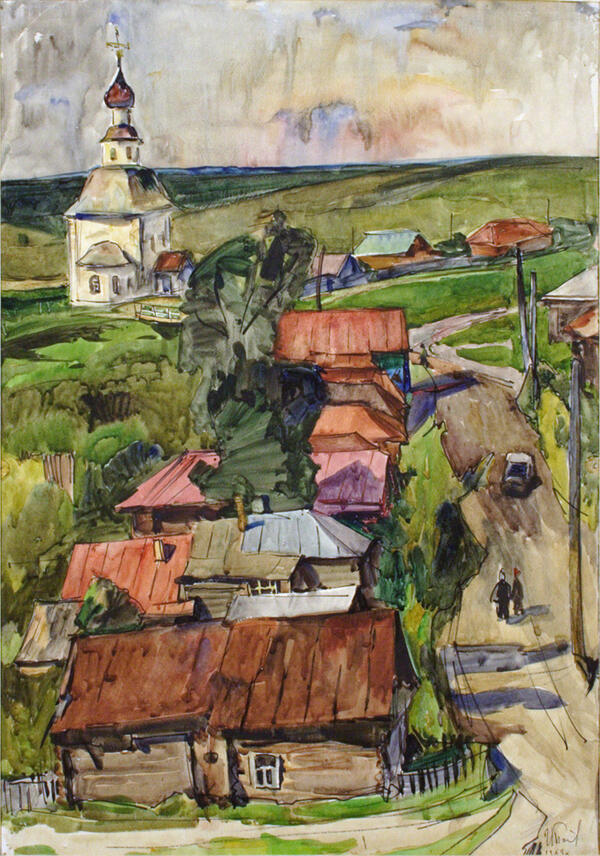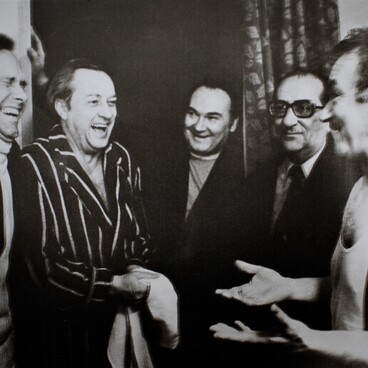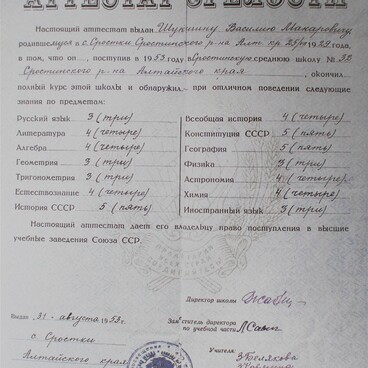In summer 1968 artist Ivan Povov supervised summer classes of watercolour painting for students in Suzdal. In his memoir The Journal of an Artist he wrote: ‘In Suzdal, I was stationed in a small town inn together with my teammate. As for our students, all 50 of them lived in Spaso-Evfimiyev Monastery. It had a traditionally bad reputation, since a prison used to be located there… However, our students quickly made themselves at home and, having learned everything and everyone, kept their spirits high. From the first days they took vivid interest in numerous temples, they drew and painted. Every evening, we had a general inspection and discussion of each sketch. Gradually, I started enjoying life in Suzdal. Conversations with the students, return to watercolour technique’.
In Suzdal, Popov met his cousin, Vasily Shukshin, who came to the town to film Strange People. ‘Once after the class, I laid down and took a nap in my room at the inn. Then the door suddenly opened without knocking, and I saw Vasily… It turned out that he had arrived with a film crew to select locations for shooting town-related scenes in his movie. We took a long walk across the town, Vasily was admiring the sites and marvelling at their proportionality’, the artist remembered.
Walking with his cousin inspired Popov to create a series of watercolour pieces that relayed the unique beauty of the ancient town. The artist painted A Lane in Suzdal from life. The plot of the piece emphasised the provincial nature of the town: one-story wooden houses, a rural road, and a high dome of the white church, which rested against a cloudy sky. But at the same time, Popov conveyed the extraordinary comfort and warmth of a calm street. The old town in his picture existed outside of time and space.
Popov was born in Altai in 1926. He lived a life that was typical for his time: tough childhood without father, mother’s death, industrial school, and work at a factory. Nevertheless, the future artist was able to fully transform his fate in post-war years. He enrolled in an art school in Kiev, and later graduated from Kiev Art Institute.
Everyday rural life and landscapes were major themes of Popov’s art throughout his life. It was on this basis that the cousins found common ground. Both tried to convey the same message to people, yet with different approaches: one used his paintings, and the other relied on cinema and literature.
In Suzdal, Popov met his cousin, Vasily Shukshin, who came to the town to film Strange People. ‘Once after the class, I laid down and took a nap in my room at the inn. Then the door suddenly opened without knocking, and I saw Vasily… It turned out that he had arrived with a film crew to select locations for shooting town-related scenes in his movie. We took a long walk across the town, Vasily was admiring the sites and marvelling at their proportionality’, the artist remembered.
Walking with his cousin inspired Popov to create a series of watercolour pieces that relayed the unique beauty of the ancient town. The artist painted A Lane in Suzdal from life. The plot of the piece emphasised the provincial nature of the town: one-story wooden houses, a rural road, and a high dome of the white church, which rested against a cloudy sky. But at the same time, Popov conveyed the extraordinary comfort and warmth of a calm street. The old town in his picture existed outside of time and space.
Popov was born in Altai in 1926. He lived a life that was typical for his time: tough childhood without father, mother’s death, industrial school, and work at a factory. Nevertheless, the future artist was able to fully transform his fate in post-war years. He enrolled in an art school in Kiev, and later graduated from Kiev Art Institute.
Everyday rural life and landscapes were major themes of Popov’s art throughout his life. It was on this basis that the cousins found common ground. Both tried to convey the same message to people, yet with different approaches: one used his paintings, and the other relied on cinema and literature.



